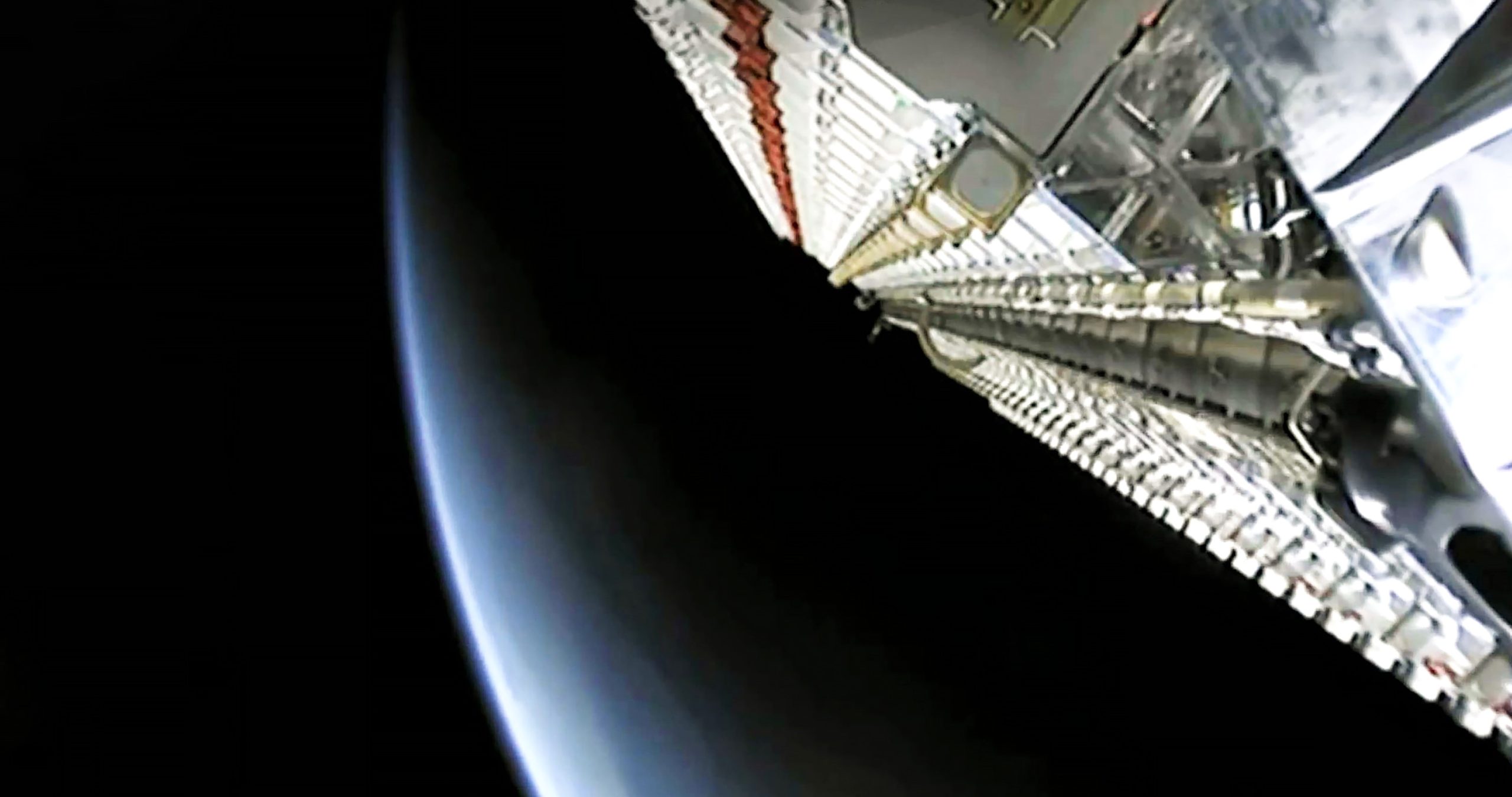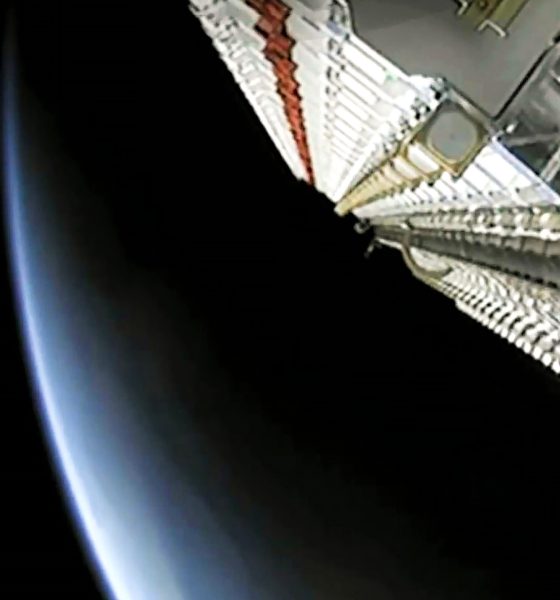

News
SpaceX CEO Elon Musk says Starlink will strive to protect and support science
On the heels of a swelling debate among astronomers about the potential negative scientific impacts of constellations like Starlink, SpaceX CEO Elon Musk says that the company will “make sure [it] has no material effect on … astronomy.”
Additionally, Musk noted that he had already asked Starlink engineers to examine methods of reducing the albedo (i.e. reflectivity) as one potential upgrade for future satellites. Most importantly, however, the 60 satellites launched on March 23rd are just three days into their orbital debut. As the first flight of an entirely new SpaceX-built satellite bus, this is SpaceX’s first time ever attempting to launch or operate so many of its own spacecraft, and Starlink v0.9 is no less of an experiment for SpaceX than it is for unaffiliated observers.
SpaceX’s first 60 finalized Starlink satellites have only just begun the process of on-orbit checkouts and are likely no less than one or several weeks away from some form of commissioning, in which each spacecraft will begin seriously testing its payloads. At the moment, the satellites still need to climb to their final orbits (550 km vs. 450 km) with their own electric ion thrusters and have yet to begin anything resembling static operations.
Once they’ve fully circularized their orbits at 550 km, the 60 (hopefully) satellites can begin those commissioning procedures. This will likely be the first flight-test for a number of new SpaceX-built or designed technologies, ranging from wholly unproven hardware or improved variants of components from the Tintin era to the radically new form factor of the unflown Starlink bus. This includes as many as four in-house phased array antennas per satellite, described by Musk as some of the most advanced commercial antennas in the world.

More than “interference” protection
However, aside from Musk’s assurance that SpaceX would do everything it can to minimize or even entirely prevent interference with scientific research and science-critical astrophotography, the CEO also expressed awareness of the many potential ways Starlink could actually benefit astronomy and other space sciences. Most notably, what SpaceX has actually arrived at with Starlink v0.9 is an extraordinarily cheap, high-performance satellite bus capable of supporting significant payloads, be it high-throughput antennas or something more exotic.
That “something” could be fairly wide-reaching, including astrophysics payloads, radio instruments, lasers, cameras, and maybe even telescopes. Additionally, thanks to their relatively efficient and low-cost ion thrusters, individual Starlink satellites could even be capable of radically changing their orbits, potentially even escaping Earth and heading to destinations like the Moon, Mars, and near-Earth asteroids/comets. Musk has repeatedly raised the possibility of building and launching SpaceX’s own Starlink-based interplanetary spacecraft, a potentially revolutionary concept thanks to their low cost.
Despite the potential scientific value, the fact remains that space-based observatories are unlikely to fully match the ease, affordability, and accessibility of ground-based telescopes for scientific observations for decades, if ever. Until then, SpaceX thankfully sounds more than willing to cooperate closely with international science communities to mitigate or fully prevent the disruption of ongoing research.
Check out Teslarati’s Marketplace! We offer Tesla accessories, including for the Tesla Cybertruck and Tesla Model 3.

News
Tesla FSD fleet is nearing 7 billion total miles, including 2.5 billion city miles
As can be seen on Tesla’s official FSD webpage, vehicles equipped with the system have now navigated over 6.99 billion miles.

Tesla’s Full Self-Driving (Supervised) fleet is closing in on almost 7 billion total miles driven, as per data posted by the company on its official FSD webpage.
These figures hint at the massive scale of data fueling Tesla’s rapid FSD improvements, which have been quite notable as of late.
FSD mileage milestones
As can be seen on Tesla’s official FSD webpage, vehicles equipped with the system have now navigated over 6.99 billion miles. Tesla owner and avid FSD tester Whole Mars Catalog also shared a screenshot indicating that from the nearly 7 billion miles traveled by the FSD fleet, more than 2.5 billion miles were driven inside cities.
City miles are particularly valuable for complex urban scenarios like unprotected turns, pedestrian interactions, and traffic lights. This is also the difference-maker for FSD, as only complex solutions, such as Waymo’s self-driving taxis, operate similarly on inner-city streets. And even then, incidents such as the San Francisco blackouts have proven challenging for sensor-rich vehicles like Waymos.
Tesla’s data edge
Tesla has a number of advantages in the autonomous vehicle sector, one of which is the size of its fleet and the number of vehicles training FSD on real-world roads. Tesla’s nearly 7 billion FSD miles then allow the company to roll out updates that make its vehicles behave like they are being driven by experienced drivers, even if they are operating on their own.
So notable are Tesla’s improvements to FSD that NVIDIA Director of Robotics Jim Fan, after experiencing FSD v14, noted that the system is the first AI that passes what he described as a “Physical Turing Test.”
“Despite knowing exactly how robot learning works, I still find it magical watching the steering wheel turn by itself. First it feels surreal, next it becomes routine. Then, like the smartphone, taking it away actively hurts. This is how humanity gets rewired and glued to god-like technologies,” Fan wrote in a post on X.
News
Tesla starts showing how FSD will change lives in Europe
Local officials tested the system on narrow country roads and were impressed by FSD’s smooth, human-like driving, with some calling the service a game-changer for everyday life in areas that are far from urban centers.

Tesla has launched Europe’s first public shuttle service using Full Self-Driving (Supervised) in the rural Eifelkreis Bitburg-Prüm region of Germany, demonstrating how the technology can restore independence and mobility for people who struggle with limited transport options.
Local officials tested the system on narrow country roads and were impressed by FSD’s smooth, human-like driving, with some calling the service a game-changer for everyday life in areas that are far from urban centers.
Officials see real impact on rural residents
Arzfeld Mayor Johannes Kuhl and District Administrator Andreas Kruppert personally tested the Tesla shuttle service. This allowed them to see just how well FSD navigated winding lanes and rural roads confidently. Kruppert said, “Autonomous driving sounds like science fiction to many, but we simply see here that it works totally well in rural regions too.” Kuhl, for his part, also noted that FSD “feels like a very experienced driver.”
The pilot complements the area’s “Citizen Bus” program, which provides on-demand rides for elderly residents who can no longer drive themselves. Tesla Europe shared a video of a demonstration of the service, highlighting how FSD gives people their freedom back, even in places where public transport is not as prevalent.
What the Ministry for Economic Affairs and Transport says
Rhineland-Palatinate’s Minister Daniela Schmitt supported the project, praising the collaboration that made this “first of its kind in Europe” possible. As per the ministry, the rural rollout for the service shows FSD’s potential beyond major cities, and it delivers tangible benefits like grocery runs, doctor visits, and social connections for isolated residents.
“Reliable and flexible mobility is especially vital in rural areas. With the launch of a shuttle service using self-driving vehicles (FSD supervised) by Tesla in the Eifelkreis Bitburg-Prüm, an innovative pilot project is now getting underway that complements local community bus services. It is the first project of its kind in Europe.
“The result is a real gain for rural mobility: greater accessibility, more flexibility and tangible benefits for everyday life. A strong signal for innovation, cooperation and future-oriented mobility beyond urban centers,” the ministry wrote in a LinkedIn post.
News
Tesla China quietly posts Robotaxi-related job listing
Tesla China is currently seeking a Low Voltage Electrical Engineer to work on circuit board design for the company’s autonomous vehicles.

Tesla has posted a new job listing in Shanghai explicitly tied to its Robotaxi program, fueling speculation that the company is preparing to launch its dedicated autonomous ride-hailing service in China.
As noted in the listing, Tesla China is currently seeking a Low Voltage Electrical Engineer to work on circuit board design for the company’s autonomous vehicles.
Robotaxi-specific role
The listing, which was shared on social media platform X by industry watcher @tslaming, suggested that Tesla China is looking to fill the role urgently. The job listing itself specifically mentions that the person hired for the role will be working on the Low Voltage Hardware team, which would design the circuit boards that would serve as the nervous system of the Robotaxi.
Key tasks for the role, as indicated in the job listing, include collaboration with PCB layout, firmware, mechanical, program management, and validation teams, among other responsibilities. The role is based in Shanghai.
China Robotaxi launch
China represents a massive potential market for robotaxis, with its dense urban centers and supportive policies in select cities. Tesla has limited permission to roll out FSD in the country, though despite this, its vehicles have been hailed as among the best in the market when it comes to autonomous features. So far, at least, it appears that China supports Tesla’s FSD and Robotaxi rollout.
This was hinted at in November, when Tesla brought the Cybercab to the 8th China International Import Expo (CIIE) in Shanghai, marking the first time that the autonomous two-seater was brought to the Asia-Pacific region. The vehicle, despite not having a release date in China, received a significant amount of interest among the event’s attendees.








